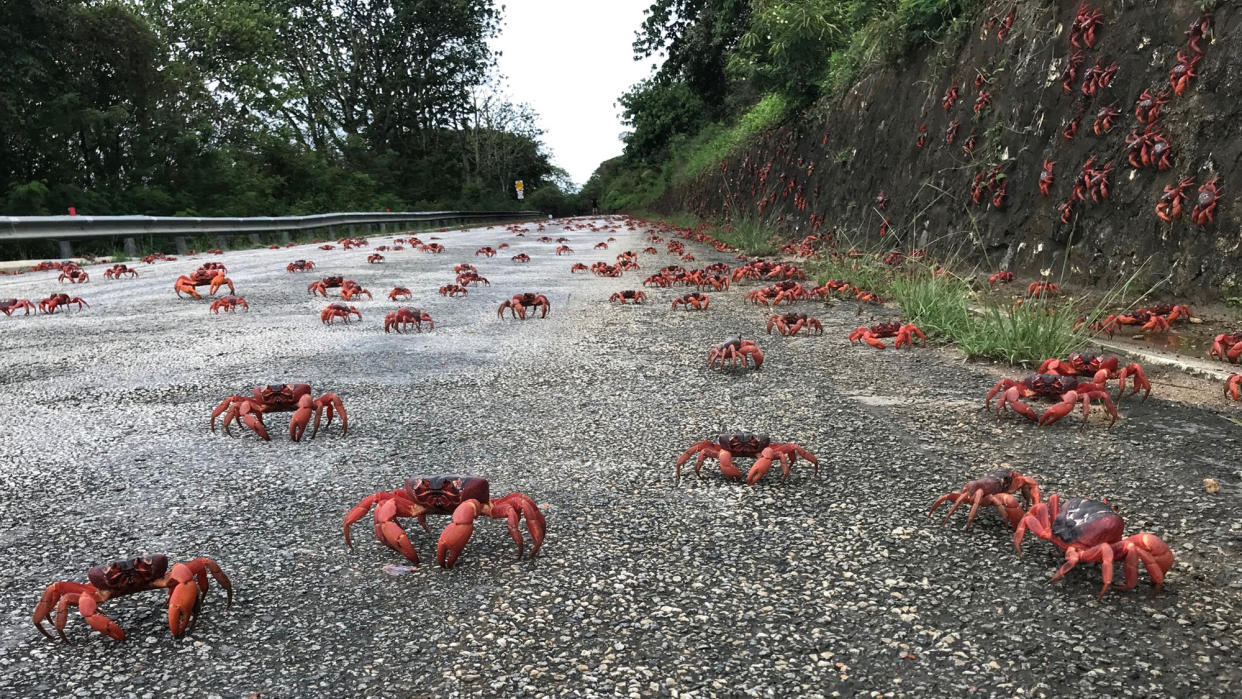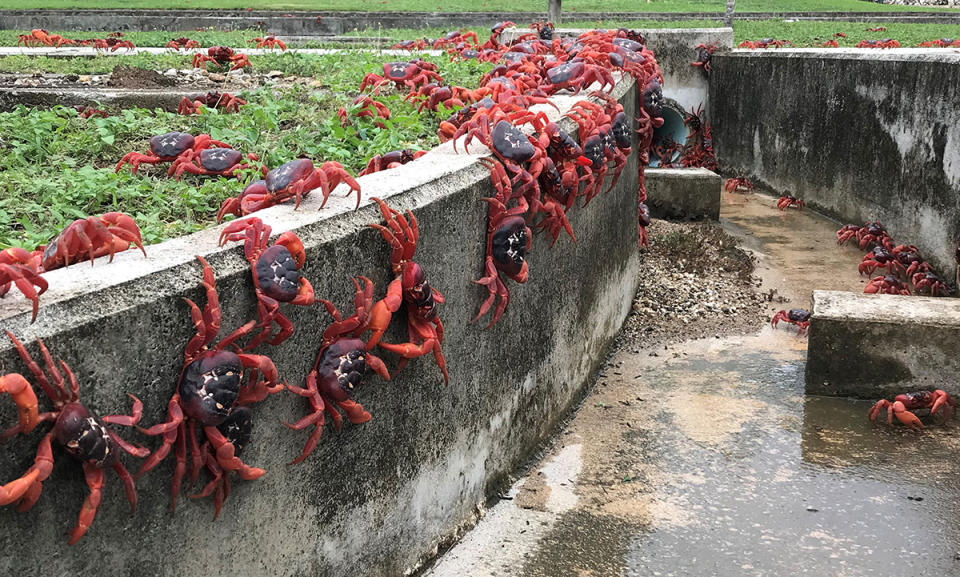Millions of crabs scuttle across this island every year

With the onset of the rainy season, Christmas Island transforms. Roads shut down, the forest floor comes alive, and tens of millions of red crabs take over. The remote Australian territory, located about 190 nautical miles south of Indonesia, is host to one of the world’s most singular natural occurrences. There, like clockwork each year, red crabs emerge from their burrows en masse and move to the Indian Ocean, guided by rainfall and lunar cycles. Thick-legged, hard-shelled bodies, about five or fewer inches across, cover the 52 square mile island as they embark from land to sea.
“It’s a spectacular event that few people get to see,” says Brendan Tiernan, Christmas Island National Park’s senior field program coordinator for threatened species. Tiernan has lived and worked on the island for 17 years, as one of its approximately 1,500 residents. Still, each year, he bears an eager witness to “one of the great animal migrations.”
Decades of a destructive invasive species put a big dent in the red crab populations and in 2023 an unusually dry year disrupted the crustaceans’ reproductive ritual. Yet despite these setbacks (and thanks to active management), Tiernan says the crabs are currently thriving. In 2015, there were about 45-50 million red crabs on Christmas Island. Now, Tiernan says there are over 100 million. Through their numbers and unique life cycle, they shape their island home.
Ecosystem engineers
Christmas Island red crabs (Gecarcoidea natalis) are a species with a small range. They’re native to just two places: most live on their eponymous isle and a much smaller population inhabits an archipelago called Cocos Islands about 600 miles southeast. For the majority of the year, the crabs inhabit forests. They’re detritivores, living strictly on the ground and in subsurface burrows where they feed on decaying vegetation as well as young seedlings.
In parts of Christmas Island where the crabs are numerous, the forest floor is devoid of leaf litter. “It looks like it’s been raked, and it’s potholed like a moon-cratered landscape with their burrows,” Teirnan tells Popular Science. “You end up with a really unusual forest structure where there’s no understory and you can see for miles and miles. It looks like nothing else,” he adds. In other tropical places, such an empty understory might be a sign of trouble, but on Christmas Island it’s the natural state of things. The crabs dictate their environment.
Despite their big impact, most of the time the crabs aren’t particularly active or conspicuous. They might breathe air, but they’re still “moisture loving creatures,” Tiernan says. As a result, they spend most of the dry season inside their burrows. But when the rains come, it’s a different story.
Beach bound
In late October or November, Christmas Island generally gets its first significant rainfall of the coming wet season. From there, the crabs begin their countdown. They need to make it to the ocean in time to spawn within a few days of the last quarter moon, when the tides are at their gentlest, and least likely to wash away their young.
Red crabs leave their forest burrows with the initial rainfall and head towards the coast. “It’s millions of crabs crossing roads and walking over cliffs,” says Tiernan. Somehow, the crustaceans are aware enough of the lunar cycle to adjust the speed of their migration to be faster or more leisurely, depending on how long they have before the last quarter moon and neap tide. The mysterious moon-tracking ability means that some years, “they’ll take their time and meander along very slowly. Other years, they have a tight time budget and you’ll just get this roaring stampede as they all race towards the ocean,” he explains.

Males generally make it to the coast first, where they construct mating burrows. When females arrive, Tiernan says they select the “biggest male with the best burrow” that they can find, and the crabs mate. Once mated, the males return to the forest and the females enter the coastal burrows to brood their eggs–about 100,000 each. The gravid crabs exit their burrows soon after the last quarter moon and release their eggs into the ocean in a mass-coordinated, frantic up-and-down dance, at around 4am, a couple of hours before dawn.
Immediately upon hitting the water, the eggs hatch into wriggling larvae called “megalops.” The crabs stay at this life stage for about four weeks, until they return to land, molted into tiny crablings. Breeding success varies significantly from year-to-year. “Some years we get an incredible number of baby crabs returning. Other years we get absolutely nothing,” Tiernan notes. Why is something of a mystery. Little is known about the marine stage of the crabs’ life cycle, he says. But in successful years, literally trillions of baby crabs make it back to shore in “this big carpet of red.”
Resilient red tide
Over the last decade, Tiernan says there’s been a spate of massive crabling returns–markedly increasing the population. “It’s a noticeable change across the landscape. There’s more crabs,” he says. Yet for much of recent history, it wasn’t this way.
The spread of invasive yellow crazy ants in the 1990’s led to “invasional meltdown.” Yellow crazy ants killed crabs by the millions, spraying formic acid in their eyes and joints in a bid to defend their “supercolony” territories, which can span hundreds of acres. Red crab numbers plummeted through the 2000’s and into the 2010’s, as the ants took over the island. In their wake and in the absence of the crabs, sections of forest changed, developing dense understories and deep leaf litter–transforming the fundamental makeup of the habitat and leaving it inhospitable for other animals native to Christmas Island. Pesticide baits helped to manage the ant problem, but also killed more crabs.
But in 2016, the tide began to shift in the crabs’ favor with the introduction of a biocontrol agent. Australia’s national park agency bred and released a teeny tiny wasp. The Malaysian insect counterintuitively doesn’t target the ants, but rather a scale insect that the ants depend on for their food source. Within just a few years, monitoring revealed the wasp was working. Crazy ant numbers were down and crabs began to rebound. “It’s made it much easier for red crabs to migrate and to live on the island without being decimated by the yellow crazy ants,” says Tiernan.
The war isn’t totally won, he notes. The park is looking into new ways to apply pesticide treatments and additional biocontrols to eliminate even more ants. At the moment, though, things are looking up for the crabs and the whole Christmas Island ecosystem as a result.
That’s even after last year, where a much-delayed rainy season effectively halted the mega-migration from occurring. The first rains came in February, and the crabs didn’t head to the coast in anywhere near their usual quantities.
It’s rare, but not unheard of for the crabs to skip a breeding season in accordance with anomalous weather, Tiernan says. It happened once before in 1997 during a particularly intense El Niño event. Plus, Christmas Island’s climate is subject to the Indian Ocean Dipole, an oscillating pattern similar to the El Niño-Southern Oscillation, which can intermittently lead to exceptionally dry and wet years. Some level of irregularity is to be expected.
However, climate change is set to make things harder for the island and the crabs in the long-term. According to a recent study commissioned by the national park, Tiernan says that Christmas Island is set to have longer dry periods and shorter, more intense wet periods as global warming progresses. If that probability pans out, the red crabs will struggle to stay fed and hydrated through the dry season, and face a more treacherous wet season migration and breeding period. The crustaceans have proved resilient so far, yet there’s no guarantee they make it over the next hurdle.
At least for this year though, Tiernan expects a good turnout. “There’s no reason why we shouldn’t get a return to an enormous crab migration.” In a few months time, Christmas Island will be decked all in red once again.

